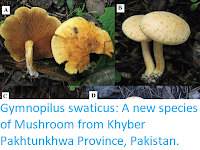Milkcap Mushrooms, Russulaceae, are a widespread group of often edible, ectomycorrhizal (Plant-Fungus relationship in which the root is surrounded by a sheath of Fungi) Basidiomycote Fungi, which produce gilled Mushrooms with notable brittle flesh. Members of the genus Lactifluus are widely distributed in the tropics, as well as in some temperate parts of Australia. They are the dominant group of ectomycorrhizal Fungi in the lowland rainforests of southern Cameroon and northern Gabon, where they form symbiotic relationships with trees of the genera Uapaca, an edible-fruit producing group found in mixed rainforests across Africa and Madagascar, and Gilbertiodendron, a Leguminous tree producing large monospecific stands.
In a paper published in the journal MycoKeys on 28 January 2019, Eske De Crop and Jonas Lescroart of the Research Group Mycology at Ghent University, André-Ledoux Njouonkou of the Department of Biological Sciences at the University of Bamenda, and Ruben De Lange, Kobeke Van de Putte and Annemieke Verbeken, also of the Research Group Mycology at Ghent University, describe a new species of Milkcap Mushroom from the Dja Biosphere Reserve in southeast Cameroon.
The new species is named Lactifluus bicapillus, from 'bi' meaning 'two' and 'capillus' meaning the terminal hyphae in the skin of a Mushroom, as these cells have two distinct forms in this species. Lactifluus bicapillus produces Mushrooms 34-79 mm in diameter, the outer margin of which arches upward as they age. These Mushrooms are rust-coloured at their centres, fading to pale orange around their margins.
See also...
Basidiomata of Lactifluus bicapillus. (a)–(c) Basidiomata of Lactifluus bicapillus, (d) detail of lamellae, (e) young specimen, (f) detail of latex, (g) detail of brown colour change of the latex. Eske De Crop & Annemieke Verbeken in De Crop et al. (2019).
See also...
Follow Sciency Thoughts on Facebook.







